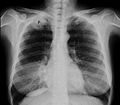Pancoast tumor
| Classification according to ICD-10 | |
|---|---|
| C34.1 | Malignant neoplasm: upper lobe (bronchus) |
| ICD-10 online (WHO version 2019) | |
| Classification according to ICD-O-3 | |
|---|---|
| C34.1 | Upper lobe of the lung |
| 8010/3 | Carcinoma NOS |
| ICD-O-3 first revision online | |
The Pancoast tumor (syn. Apical sulcus tumor ) - named after the American radiologist Henry Pancoast (1875-1939) - is a rapidly progressing peripheral bronchial carcinoma in the area of the apex pulmonis or the upper pulmonary furrow, which relatively quickly affects the ribs , Cervical soft parts, arm mesh and vertebrae. This is why this tumor is also known as the “ breakout cancer ”.
The tissue of the tumors does not differ from other lung carcinomas. The first person to describe it was the American radiologist Henry Pancoast (1875-1939).
The disease often manifests itself with a characteristic Pancoast syndrome :
- Shoulder / arm pain
- Paresthesia (abnormal sensation) of the forearm
- Paresis (paralysis)
- Hand muscle atrophy
- Upper congestion due to narrowing of the neck veins
- Rib pain
- Horner syndrome (damage to the autonomic nervous system)
... and in computed tomography .
Web links
swell
Urban & Fischer; Lexicon editing. Roche Lexicon Medicine. Munich; Elsevier, Urban & Fischer, 2003, ISBN 3-437-15150-9 .

